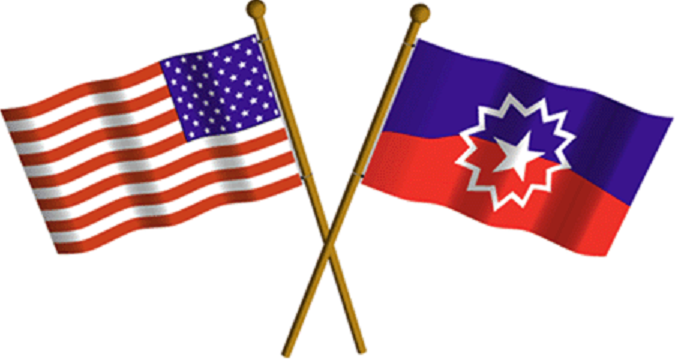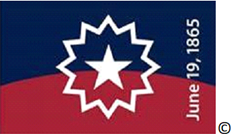JUNETEENTH 101
The March to Juneteenth
June 19, 1862, to June 19, 1866
PREFACE:
“On June 16, 1858, Abraham Lincoln accepted the Republican nomination for President of the United States. The election of 1860 was one of the most pivotal presidential elections in American history. The main issue of the election was slavery and states’ rights. Lincoln emerged victorious and became the 16th President of the United States. Abolitionist and American treasure Frederick Douglass, in his capacity as the 1st Black Presidential-Elector, NY stated,” Slaveholders know the day of their power is over when a Republican President is elected.”
In an attempt to form their own country (in order to protect the institution of slavery) eleven southern slave-holding states formed an alliance, called the Confederacy, and seceded from the United States in 1861. “The War Between the States,” began in April 1861, when South Carolinians (members of the Confederate States of America) launched an attack on Fort Sumter in Charleston harbor. The Confederacy was initially formed by seven secessionist slave-holding States South Carolina, Mississippi, Florida, Alabama, Georgia, Louisiana, and Texas—in the Lower South region of the United States, whose economy was heavily dependent upon agriculture, particularly cotton, and a plantation system that relied upon the labor of African-American slaves. After the Civil War began, four other states-Virginia, Arkansas, Tennessee, and North Carolina joined the Confederacy to maintain their rights to hold slaves captive as free labor. Hence the bloodiest war in America’s history ensued.
“We have dissolved the late Union chiefly because of the negro quarrel … We have called our negroes ‘slaves’, and we have recognized and protected them as persons and our rights to them as property.” Stated Robert Hardy Smith, in an Address to the Citizens of Alabama on the Constitution and Laws of the Confederate States of America in 1861.
Frederick Douglass argued that the enlistment of black soldiers would help the North win the war and would be a huge step in the fight for equal rights: “Once [you] let the black man get upon his person the brass letters, U.S.; let him get an eagle on his button, and a musket on his shoulder and bullets in his pocket,” Douglass said, “and there is no power on earth which can deny that he has earned the right to citizenship.” Ultimately, sixteen African American soldiers won the Congressional Medal of Honor for their brave service in the fight for their freedom during the Civil War.
1862
June 19th
CHAPTER CXI–An Act to secure Freedom to all Persons within the Territories of the United States.
Be it enacted by the Senate and House of Representatives of the United States of America in Congress assembled that from and after the passage of this act there shall be neither slavery nor involuntary servitude in any of the Territories of the United States now existing, or which may at any time hereafter be formed or acquired by the United States, otherwise than in punishment of crimes whereof the party shall have been duly convicted.
SIGNED and APPROVED, by President Abraham Lincoln, June 19, 1862.
July
- July 4, Lincoln reminded the embattled nation, “All men created equal” (but, this still did not include African Americans).
- July 12, Border States reject the Emancipation Proclamation to free enslaved people.
- After two grueling years of war, President Lincoln began to reconsider black soldiers, as equals and human enough to die for their freedom. Besides, the Union Army badly needed soldiers. White volunteers were dwindling, and African-Americans were more eager to fight than ever.
- On July 17, Lincoln signed the Congress 2ND Confiscation Act of 1862 … any Confederate official, military or civilian, who did not surrender within 60 days of the act’spassage would have their slaves freed in criminal proceedings; and, thereby the first step towards the enlistment of African Americans in the Union Army.
August
- August 4, 1st United States Colored Combat Troop (USCT)—Kansas Regiment
- August 25, US War Department began recruiting Colored Combat Troop in Gullah Geechee territory on the Sea Islands.
September
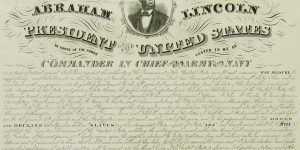
It was on September 22, 1862, that the Emancipation Proclamation was issued by Abraham Lincoln, the President of the United States, proclaiming January 1, 1863, the day that “all persons held as slaves within ANY state … thenceforth and FOREVER FREE, and the Executive Government of the United States (and entities thereof) will recognize and maintain the freedom of such persons; and will do no act or acts to repress such person in any efforts they may make for their actual freedom (and the celebration thereof).
November
- George McClellan was general-in-chief of the Union Army. Like many people at the time, McClellan opposed the outright abolition of slavery, though he was committed to the preservation of the Union. General McClellan led the Battle of Antietam, which was the single bloodiest day of combat in the Civil War. Frustrated that General McClellan had failed to destroy Lee’s army, Lincoln officially removed him from command in November 1862.
December
- December 31 Lincoln signs legislation for the new “Free State” of West Virginia.
- African Americans hold Midnight Watch to Emancipation Proclamation
1863
January
- January 1, 1863 church bells ring…FREEDOM
A NEW ERA has begun!
Lincoln used the war powers of the presidency to issue the Emancipation Proclamation re-ordering the freedom of all enslaved people in the areas “in rebellion” (the Confederacy) declaring … “”All persons held as slaves within any State or designated part of a State, the people whereof shall then be in rebellion against the United States, shall be then, thenceforward, and forever free; and the Executive Government of the United States, including the military and naval authority thereof, will recognize and maintain the freedom of such persons, and will do no act or acts to repress such persons, or any of them, in any efforts they may make for their actual freedom.”
The mandate did not exempt border states and those areas of slave states not in rebellion and therefore beyond the reach of the constitutional war power to emancipate its enslaved people. However, as soon as the Union Army arrived, it did liberate the enslaved in that area. On the first day, it affected tens of thousands of enslaved people.
Some blacks took this as their cue to begin forming infantry units of their own.
- African Americans from New Orleans formed three National Guard units: the 1st, 2nd, 3rd Louisiana Native Guard. These became the 73rd, 74th, and 75th United States Colored Infantry.
- The First KansasColored Infantry—79th United States Colored Infantry (fought in the October 1862 skirmish at Island Mound, Missouri).
- The First South Carolina Infantry—33rd United States Colored Infantry (went on its first expedition in November 1862).
These unofficial regiments were officially mustered into service in January 1863.
February
- February, the abolitionist Governor John A. Andrew of Massachusetts issued the Civil War’s first official call for black soldiers. More than 1,000 men responded from as far away as Canada and the Caribbean. Frederick Douglass’ son Charles Douglass was the first to enlist in the United States Colored Troops, USCT.
They formed the 54th Massachusetts Infantry Regiment, the first black regiment to be raised in the North.
- February New state West Virginia allows emancipation of its enslaved population!
- February 18, Lincoln/Congress sign a treaty w/England to increase the suppression of the International slave trade.
- February 24 Fred Douglass, Recruiter for USCT in MA
- “MEN OF COLOR, TO ARMS” posters reprinted nationwide!
March
- March 16, New Freedmen’s Bureau
May
- 60-day Battle of Port Hudson, USCT
- 73rd USCT—Andre Cailloux,1825 – May 27, 1863, was one of the first African American officers in the Union Army to be killed in combat during the Civil War. He died heroically during the Siege of Port Hudson,
June
- June 4, War Department pays USCT less money and no bounties.
- June 7,” African Brigade” 9th LA USCT, 5th Colored heavy artillery fought off a Rebel attack at Milliken’s Bend. Louisiana’s newly recruited slaves fought hand-to-hand and got high praise from Generals Grant, Stanton, Lincoln, et al!
- Harriet Tubman became the first woman to lead an assault during the Civil War at the Combahee River Raid, she set nearly 70 enslaved people free.
July
July 1863 was an extraordinarily bloody and decisive month, beginning with a three-day confrontation between General Robert E. Lee’s Army of Northern Virginia and Maj. Gen. George G. Meade’s Army of the Potomac around the Pennsylvania town of Gettysburg. On the 4th, the Confederates suffered defeat at Helena, Ark., and, more important, surrendered the essential Mississippi River stronghold of Vicksburg.
Black and Native American soldiers outnumbered whites in an overlooked July 1863 clash in what is now Rentiesville, Oklahoma
The Battle of 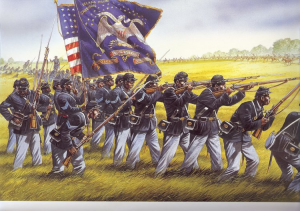 Honey Springs, the climatic engagement of the Civil War in Indian Territory, was fought on July 17, 1863, and had been in the making since the beginning of the war. Then, as part of an overall plan for conquering the Confederacy, Federal forces invaded Indian Territory.
Honey Springs, the climatic engagement of the Civil War in Indian Territory, was fought on July 17, 1863, and had been in the making since the beginning of the war. Then, as part of an overall plan for conquering the Confederacy, Federal forces invaded Indian Territory.
July 18, the 54th Massachusetts stormed Fort Wagner, which guarded the Port of Charleston, SC. It was the first time in the Civil War that African American troops led an infantry attack. Unfortunately, the 600 men of the 54th were outgunned and outnumbered-were killed. This is the storyline for the movie “Glory.”
July 30, Lincoln legislative order forbids mistreatment of African American Prisoners of War (POWs
August

August 10, Frederick Douglass (Frederick Augustus Washington Bailey) After escaping from slavery in Maryland he became a national leader of the abolitionist movement in Massachusetts and New York. He was a living counter-example to slaveholder’s arguments that slaves lacked the intellectual capacity to function as independent American citizens. Even Northerners found it hard to believe that such a great orator had once been enslaved. Douglass meets with Lincoln to recruit and gather support for the unequal pay and treatment of Black soldiers. The U.S. Army paid black soldiers $10 a week (minus a clothing allowance, in some cases), while white soldiers got $3 more (plus a clothing allowance, in some cases). Congress passed a bill authorizing equal pay for black and white soldiers in 1864.
October
- 79th USCT fights in Kansas, MO.
November
- November 19, Lincoln delivers Gettysburg Address
December
- December 8, Lincoln prepares Notes on Reconstruction; end of slavery is in sight.
1864
March
- March 13, Lincoln drafts a letter to Louisiana asking for Black voting rights.
- March 16, Voters in AR ratify the abolition of slavery.
April
- April 8, Senate passed the 13th
- April 12, Ft. Pillow Massacre, TN; 300+ black soldiers were killed; atrocities last 6 months.
June
- June 15, House fails to vote on 13th
- President Lincoln signs a bill for retroactive equal pay.
- June 28, Lincoln signs Repeal of the Fugitive Slave Act.
July
- July 30, Battle of the Crater, Petersburg. Virginia
August
- August 16, Fredrick Douglass meets Lincoln, worried more slaves not moving to Emancipation. Lincoln asks Douglass to send scouts through Rebel lines to encourage more.
September
- September 5, Voters in Louisiana ratify the abolition of slavery.
- September 29, Battle of Chaffin’s Farm, 14 USCT earns Medal of Honor.
- September 29, Battle of New Market 200 “Butler, USCT Medal”
October
- October 13, Voters in Maryland ratify the abolition of slavery.
- October 29, Lincoln Meets Sojourner Truth; 1st Black woman to sue in court against a white man and won.
November
- November 8, Lincoln was Re-elected president.
1865
January
- January 11, Missouri Constitution abolishes slavery.
- January 13, the US House of Reps passed the 13th Amendment!
- January 16, General Sherman Field Order #16; “40 acres and a mule.”
February
- February 1, Lincoln signs the 13th Amendment!
- IL “Black Laws” repealed
- February 22, TN Constitution abolishes slavery.
March
- March 3, Lincoln Signs an order for the freedom of wives and children of Black soldiers’ families.
- Lincoln signs a bill for Freedmen’s Bureau.
- March 4, Lincoln Inaugural
- March 28, Last spring offensive begins Richmond/Petersburg, VA.
April
After four long bloody years, the Confederate army’s stronghold surrendered to the United States in April of 1865. The war bankrupted the South, and all but wiped out an entire generation of men leaving more than 620,000 men dead; more than any other war in American history. But when the war ended, in April 1865, only about fifteen percent (15%) of the enslaved had actually been freed.
- April 9, General Robert E. Lee surrenders at Appomattox
- April 11, Lincoln’s last speech; offers some Black men voting rights.
- April 12, the War of Rebellion officially ends!!!
- April 14/15, Abraham Lincoln was assassinated.
- April 16, Some USCT Regiment is rushed back to DC funeral.
Black Soldiers in the Civil War
According to the National Archives:
“By the end of the Civil War, roughly 179,000 black men (10% of the Union Army) served as soldiers in the U.S. Army and another 19,000 served in the Navy. Nearly 40,000 black soldiers died over the course of the war-30,000 of infection or disease. Black soldiers served in artillery and infantry and performed all noncombat support functions that sustain an army, as well. Black carpenters, chaplains, cooks, guards, laborers, nurses, scouts, spies, steamboat pilots, surgeons, and teamsters also contributed to the war cause. There were nearly 80 black commissioned officers. Black women, who could not formally join the Army, nonetheless served as nurses, spies, and scouts.
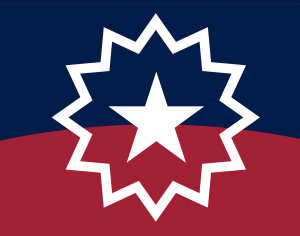 June 19, Galveston, TX Juneteenth!
June 19, Galveston, TX Juneteenth!
The enslaved people in Texas didn’t get the word until June 19, 1865. The state’s Government simply chose not to be in compliance with Federal law and opted instead to conceal the Executive mandate by coalescing with the elite plantation owners, who for the most part was the aristocracy of the time, known as The Planter Society, to facilitate the harvesting of their cotton. Freedom was not known until Major General Gordon Granger arrived in Galveston, TX on June 18th with more than 4,000 United States Colored Troops USCT. On June 19th, 1865, Granger issued General No.3 advising all, that slaves had been freed by the Emancipation Proclamation and it was posted on the door of Reedy Chapel. Thus, began what is now known as Juneteenth. It is the oldest nationally celebrated commemoration of the ending of slavery in the United States. The celebration not only commemorates African American freedom throughout America, but Juneteenth also emphasizes education and achievement internationally. It is a day, a week, and in some areas a month marked with celebrations, guest speakers, picnics, and family gatherings. It is a time for reflection and rejoicing. It is a time for assessment, self-improvement, and planning for the future. It had to be providence for USCT’s arrival in Galveston, as they were on their way as a show of force to the Texas-Mexico border against a French incursion, to deliver the news of freedom.
December
- December 6, 13th Amendment ratified; slavery abolished.
December 31/January 1, first formal, organized Juneteenth
1866
January
January 1, Freedom Day Celebration in Galveston Texas
June
- 14 June 1866 was the official end of slavery in the Territory:
Regarding the four major treaties that were negotiated and formally signed in 1866 – one with the Cherokee, the Creek, the Seminole, and a combined treaty with the Chickasaw and Choctaw. These treaties each contained four major provisions. To begin with, as punishment for aiding the Confederate rebellion, each tribe forfeited lands amounting to about half of their designated protected territory. The second provision of these treaties declared a general amnesty for all Native Americans
The final two provisions concerned ending slavery. Language identical to that in the 13th Amendment was written into each treaty, guaranteeing a final end to the institution of slavery the final provision provided for the adoption of all freed slaves as immediate and recognized citizens within their respective tribes.
- 19 June 1866, Juneteenth the first of many anniversaries. Juneteenth commemorations take place across America
HISTORIC JUNETEENTH SUMMARY: Texas was the last state in rebellion, following the end of the Civil War, to allow enslavement. Although the rumors of freedom were widespread prior to this, actual emancipation was not announced in the last state practicing enslavement until Major General Gordon Granger landed in Galveston, Texas and issued General Order #3, on June 19, 1865, “JUNETEENTH,” almost two and a half years after President Abraham Lincoln signed the Emancipation Proclamation. JUNETEENTH is now an annual observance to celebrate the date Union soldiers enforced the Emancipation Proclamation freeing all remaining enslaved in Texas and surrounding territories.

Modern Juneteenth Movement
In 1994, the era of the “Modern Juneteenth Movement” began when a group of Juneteenth leaders from across the country gathered in New Orleans, LA, at Christian Unity Baptist Church, Rev. Dwight Webster, Pastor, to work for greater national recognition of Juneteenth. The historic meeting was convened by Rev. John Mosley, Director of the New Orleans Juneteenth Freedom Celebration. Several national Juneteenth organizations were ignited from this historic gathering including the National Juneteenth Observance Foundation (NJOF). Shortly prior to this gathering, Juneteenth America, Inc., (JAI) was founded by John Thompson, who organized the first National Juneteenth Convention & Expo, and the National Juneteenth Celebration Foundation (NJCF) founded by Ben Haith, the creator of the National Juneteenth Flag.
In 1997, through the leadership of Lula Briggs Galloway, President of the NAJL and Rev. Ronald V. Myers, Sr., M.D., Chairman of the NAJL, the U.S. Congress officially passed historic legislation recognizing Juneteenth as “Juneteenth Independence Day” in America.
As of 2019, 46 states and the District of Columbia have passed legislation to officially recognize Juneteenth. The NJOF directly contributed to 43 states legislation. The annual Congressional Juneteenth Reception and National Juneteenth Prayer Breakfast are now a Washington D.C. tradition.
NJOF Education Committee
Dr. Phyllis Tucker-Wicks – Child\Youth Studies curriculum development
Dr. C. Sade Turnipseed – Mississippi Valley State University
Calvin Pearson – Project 1619
Ron Brown – Pennsylvania Juneteenth
Deborah “Dee” Evans – NJOF Vice-Chair
Carl Adams – Author Trials of Nance
Sade Roberts-Joseph – OSW African American Museum
Helen Sims – Culture & Heritage Museums Mississippi
Elijah Haith – Juneteenth Connecticut
Deborah Kelly – Pennsylvania Juneteenth
Rosetta Funches – Oklahoma Black Museum and Performing Arts Center
Steve Williams – NJOF President
Advisor
Dr. Charles A. Taylor
Contributors
Dorscine S. Spigner-Littles, Ph.D. Professor Emeritus University of Oklahoma
NJOF Founder and Chairman
Late Rev. Ronald V. Myers, Sr. M.D.
